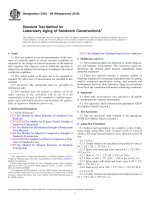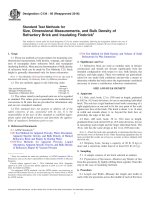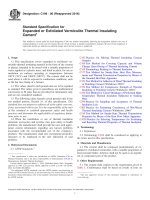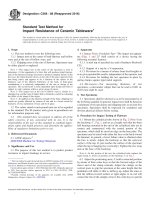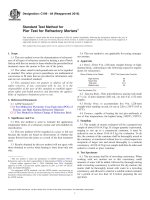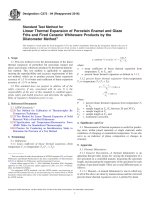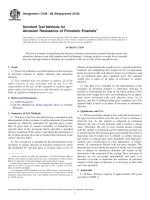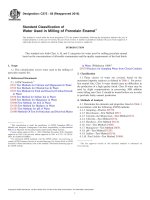Astm c 384 04 (2016)
Bạn đang xem bản rút gọn của tài liệu. Xem và tải ngay bản đầy đủ của tài liệu tại đây (202.29 KB, 9 trang )
Designation: C384 − 04 (Reapproved 2016)
Standard Test Method for
Impedance and Absorption of Acoustical Materials by
Impedance Tube Method1
This standard is issued under the fixed designation C384; the number immediately following the designation indicates the year of
original adoption or, in the case of revision, the year of last revision. A number in parentheses indicates the year of last reapproval. A
superscript epsilon (´) indicates an editorial change since the last revision or reapproval.
C634. In particular, the terms “impedance ratio,” “normal
incidence sound absorption coefficient,” and “specific normal
acoustic impedance,” appearing in the title and elsewhere in
this test method refer to the following, respectively:
1. Scope
1.1 This test method covers the use of an impedance tube,
alternatively called a standing wave apparatus, for the measurement of impedance ratios and the normal incidence sound
absorption coefficients of acoustical materials.
3.2 Definitions:
3.2.1 impedance ratio, z/ρc ≡ r/ρc + jx/ρc;
[dimensionless]—the ratio of the specific normal acoustic
impedance at a surface to the characteristic impedance of the
medium. The real and imaginary components are called,
respectively, resistance ratio and reactance ratio.
C634
3.2.2 normal incidence sound absorption coeffıcient, αn;
[dimensionless]—of a surface, at a specified frequency, the
fraction of the perpendicularly incident sound power absorbed
or otherwise not reflected.
C634
3.2.3 specific normal acoustic impedance, z ≡ r + jx;
[ML-2T-1]; mks rayl (Pa s/m)—at a surface, the complex
quotient obtained when the sound pressure averaged over the
surface is divided by the component of the particle velocity
normal to the surface. The real and imaginary components of
the specific normal acoustic impedance are called, respectively,
specific normal acoustic resistance and specific normal acoustic reactance.
C634
1.2 The values stated in SI units are to be regarded as
standard. No other units of measurement are included in this
standard.
1.3 This standard does not purport to address all of the
safety concerns, if any, associated with its use. It is the
responsibility of the user of this standard to establish appropriate safety and health practices and determine the applicability of regulatory limitations prior to use.
2. Referenced Documents
2.1 ASTM Standards:2
C423 Test Method for Sound Absorption and Sound Absorption Coefficients by the Reverberation Room Method
C634 Terminology Relating to Building and Environmental
Acoustics
E548 Guide for General Criteria Used for Evaluating Laboratory Competence (Withdrawn 2002)3
2.2 ANSI Standards:
S1.6 Preferred Frequencies and Band Numbers for Acoustical Measurements4
4. Summary of Test Method
4.1 A plane wave traveling in one direction down a tube is
reflected back by the test specimen to produce a standing wave
that can be explored with a microphone. The normal incidence
sound absorption coefficient, αn, is determined from the standing wave ratio at the face of the test specimen. To determine the
impedance ratio, z/ρc, a measurement of the position of the
standing wave with reference to the face of the specimen is
needed.
3. Terminology
3.1 The acoustical terminology used in this test method is
intended to be consistent with the definitions in Terminology
1
This test method is under the jurisdiction of ASTM Committee E33 on Building
and Environmental Acoustics and is the direct responsibility of Subcommittee
E33.01 on Sound Absorption.
Current edition approved April 1, 2016. Published April 2016. Originally
approved in 1956. Last previous edition approved in 2011 as C384 – 04 (2011).
DOI: 10.1520/C0384-04R16.
2
For referenced ASTM standards, visit the ASTM website, www.astm.org, or
contact ASTM Customer Service at For Annual Book of ASTM
Standards volume information, refer to the standard’s Document Summary page on
the ASTM website.
3
The last approved version of this historical standard is referenced on
www.astm.org.
4
Available from American National Standards Institute (ANSI), 25 W. 43rd St.,
4th Floor, New York, NY 10036, .
4.2 The normal incidence absorption coefficient and impedance ratio are functions of frequency. Measurements are made
with pure tones at a number of frequencies chosen, unless there
are compelling reasons to do otherwise, from those specified in
ANSI S1.6.
5. Significance and Use
5.1 The acoustical impedance properties of a sound absorptive material are related to its physical properties, such as
Copyright © ASTM International, 100 Barr Harbor Drive, PO Box C700, West Conshohocken, PA 19428-2959. United States
1
C384 − 04 (2016)
airflow resistance, porosity, elasticity, and density. As such, the
measurements described in this test method are useful in basic
research and product development of sound absorptive materials.
It is best to work well below these limits whether the tube is
circular or rectangular. At frequencies above these limits, cross
modes may develop and the incident and reflected waves in the
tube are not likely to be plane waves. If sound with a frequency
below the limiting value enters the tube as a non-plane wave,
it will become a plane wave after traveling a short distance. For
this reason, no measurement should be made closer than one
tube diameter to the source end of the tube.
6.1.1.3 Length—The length of the tube is also related to the
frequencies at which measurements are made. The tube must
be long enough to contain that part of the standing wave pattern
needed for measurement. That is, it must be long enough to
contain at least one and preferably two sound pressure minima.
To ensure that at least two minima can be observed in the tube,
its length should be such that:
5.2 Normal incidence sound absorption coefficients are
more useful than random incidence coefficients in certain
situations. They are used, for example, to predict the effect of
placing material in a small enclosed space, such as inside a
machine.
5.3 Estimates of the random incidence or statistical absorption coefficients for materials can be obtained from normal
incidence impedance data. For materials that are locally
reacting, that is, without sound propagation inside the material
parallel to its surface, statistical absorption coefficients can be
estimated from specific normal acoustic impedance values
using an expression derived by London (1).5 Locally reacting
materials include those with high internal losses parallel with
the surface such as porous or fibrous materials of high density
or materials that are backed by partitioned cavities such as a
honeycomb core. Formulas for estimating random incidence
sound absorption properties for both locally and bulk-reacting
materials, as well as for multilayer systems with and without
air spaces have also been developed (2).
f.0.75 c/ ~ l 2 d !
where:
l = length of tube, m.
If, for example, the tube is 1 m in length and 0.1 m in
diameter and the speed of sound is 343 m/s, the frequency
should exceed 286 Hz if two sound pressure minima are to be
observed.
6.1.2 Test Specimen Holder—The specimen holder, a detachable extension of the tube, must make an airtight fit with
the end of the tube opposite the sound source. Provision must
be made for containing the specimen with its face in a known
position. The interior cross-sectional shape of the specimen
holder must be the same as the tube itself. Provision must be
made for backing the specimen with a metal backing plate that
forms a seal with the interior of the specimen holder. A
recommended backing is a solid steel plate with a thickness of
not less than 2 cm. The sample holder may be constructed in
such a way that a variable depth air space can be provided
between the back of the test specimen and the surface of the
metal backing plate. Provision must be made for substituting
the metal backing plate for the specimen for calibration
purposes.
6.1.3 Sound Source:
6.1.3.1 Kind and Placement—The sound source may be a
loudspeaker or a horn-driver coupled to a short exponential
horn. The source may face directly into the tube or, to avoid
interference with the probe microphone, it may be placed to
one side. Since the source diameter may be larger than the tube
diameter, it is best to mount the source in an enclosure to which
the tube is connected.
6.1.3.2 Precautions—Precautions should be taken to avoid
direct transmission of vibration from the sound source to the
probe microphone where it enters the tube or to the tube itself.
Such vibrational transmission will be evidenced by a smaller
standing wave ratio (higher normal incidence sound absorption) than would be expected for the material under test.
Vibration isolation material, such as polymeric foam, may be
placed between the sound source and tube or the microphone
probe, or both, to minimize this effect. Interaction between the
sound field within the tube and the loudspeaker diaphragm may
cause the frequency response of the loudspeaker to be nonlinear. Although this has no effect on measurement accuracy, it
6. Apparatus
6.1 The apparatus is essentially a tube with a test specimen
at one end and a loudspeaker at the other. A probe microphone
that can be moved along the length of the tube is used to
explore the standing wave in the tube. The signal from the
microphone is filtered, amplified, and recorded.
6.1.1 Tube:
6.1.1.1 Construction—The tube may be made of metal,
plastic, portland cement, or other suitable material that has
inherently low sound absorption properties. Its interior cross
section may be circular or rectangular but must be uniform
from end to end. The tube must be straight and its inside
surface must be smooth, nonporous and free of dust to keep the
sound attenuation with distance low. The interior of the tube
may be sealed with paint, epoxy, or other coating material to
ensure low sound absorption of the interior surface. The tube
walls must be massive and rigid enough so that the propagation
of sound energy through them by vibration is negligible.
6.1.1.2 Diameter—For circular tubes, the upper limit (3) of
frequency is:
f,0.586 c/d
(1)
where:
f = frequency, Hz,
c = speed of sound in the tube, m/s, and
d = diameter of tube, m.
For rectangular tubes, with d used as a symbol for the larger
cross section dimension, the upper limit is:
f,0.500 c/d
(3)
(2)
5
The boldface numbers in parentheses refer to the list of references at the end of
this standard.
2
C384 − 04 (2016)
6.1.9 Monitoring Oscilloscope—While not required for any
actual measurement purpose, it is recommended that an oscilloscope be used to monitor both the voltage driving the sound
source and the output of the amplifier. Observing the oscilloscope trace is useful in locating the exact position of pressure
minima within the tube as well as in detecting distortion,
excess noise, and other possible problems in the voltage
signals.
does require awkward changes in amplifier gain settings when
switching between test frequencies. This effect can be minimized by lining the interior of the tube near the sound source
with a porous, absorbent material.
6.1.4 Microphone—If the microphone is small enough, it
may be placed inside the impedance tube connected to a rod or
other device that can be used to move it along the length of the
tube. If the microphone is placed within the tube, the total
cross-sectional area of the microphone and microphone supports shall be less than 5 % of the total cross-sectional area of
the tube. In most applications, the microphone is on the outside
connected to a hollow probe tube that is inserted through the
source end of the apparatus and is aligned with the central axis
of the tube. In principle, the sensing element of the microphone
or of the microphone probe may be positioned anywhere within
the tube cross-sectional area. In practice, the microphone or the
end of the probe tube must be supported by a spider or other
device to maintain its position on the central axis of the
impedance tube or at a constant distance from the central axis.
6.1.5 Microphone Position Indicator—A scale shall be provided to measure the position of the microphone with respect
to the specimen face. It is not necessary that zero on the scale
correspond to the position of the specimen face. The resolution
of this scale should be such that microphone position can be
measured to the nearest 1.0 mm or, if a vernier is used, to the
nearest 0.1 mm.
6.1.6 Test Signal:
6.1.6.1 Frequency—The test signal shall be provided by a
sine wave oscillator generating a pure tone chosen from the list
of preferred band center frequencies listed in ANSI S1.6. The
test frequency shall be controlled to within 61 % during the
course of a measurement. If a digital frequency synthesizer is
used, the test signal may be assumed to agree with the set point
within the required 61 %.
6.1.6.2 Frequency Counter—It may be necessary, and is
usually advisable, to measure the frequency of the signal with
an electronic counter rather than to rely on the calibration and
indicated setting of the frequency generator. Frequency should
be indicated to the nearest 1 Hz.
6.1.7 Output-Measuring Equipment:
6.1.7.1 Filter—The microphone output should be filtered to
remove any harmonics and to reduce the adverse effect of
ambient noise. The filter width must be no wider than one-third
octave, but a one-tenth octave or narrower filter bandwidth is
preferable.
6.1.7.2 Amplifier—The signal-to-noise ratio of the measuring amplifier must be at least 50 dB. The amplified signal may
be read and recorded as a voltage or as a sound pressure level
(dB). It is presumed in Sections 9 and 10 of this test method
that voltages rather than dB levels are being used. As only
pressure ratios are required for the computations in this test
method, it is not necessary that the sound pressure measurement system be calibrated to a known, reference sound
pressure level or to a known voltage.
6.1.8 Temperature Indicator—A thermometer or other ambient temperature sensing device shall be located in the vicinity
of the impedance tube. This device should indicate air temperature inside the tube to within 62°C.
7. Sampling
7.1 At least three specimens, preferably more if the sample
is not uniform, should be cut from the sample for the test.
When the sample has a surface that is not uniform (for example
a fissured acoustical tile), each specimen should be chosen to
include, in proper proportion, the different kinds of surfaces
existing in the larger sample.
8. Test Specimen Preparation and Mounting
8.1 The measured impedance properties can be strongly
influenced by the specimen mounting conditions. Therefore,
the following guidelines for the preparation and mounting of
specimens are provided.
8.2 The specimen must have the same shape and area as the
tube cross section, neither more nor less. The specimen must fit
snugly into the specimen holder, fitting not so tightly that it
bulges in the center, nor so loosely that there is a space between
its edge and the holder. Movement of the specimen as a whole
and spaces between the specimen perimeter and sample holder
can result in anomalous values of normal incidence sound
absorption. Specimen movement can be minimized by the use
of thin, double-sided adhesive tape applied between the back of
the specimen and the metal backing plate. Spaces at the
specimen perimeter can be sealed with petroleum jelly.
8.3 The specimen must have a relatively flat surface since
the reflected wave from a very uneven surface may not have
become a plane wave at the position of the first minimum. If
the specimen is an anechoic wedge, or an array of wedges,
refer to Annex A1.
8.4 When the specimen has a very uneven back, a layer of
putty-like material should be placed between it and the metal
backing plate to seal the back of the specimen and to add
enough thickness to make the back of the specimen parallel to
the front. Otherwise, the unknown airspace may be the
dominant factor in the measured results.
9. Description of Standing Wave Pattern in Tube
9.1 Fig. 1 represents microphone voltages that might be
measured in a tube at various distances from the specimen face.
That is, Fig. 1 is a standing wave pattern, in this case for a
reflective specimen installed in a one-metre tube with the tube
driven at 500 Hz. The minimum points at x1, x2, and x3 on the
standing wave pattern are spaced half a wavelength apart and
positioned midway between the maxima. It should be noted
that the data shown in Fig. 1 are plotted as voltage versus
distance rather than voltage level (in dB) versus distance.
9.2 The standing wave pattern generally contains a finite
number of discrete minima (for example, x1, x2, x3 in Fig. 1)
3
C384 − 04 (2016)
where:
p0 = the pressure at some reference position,
x
= the absolute distance traveled by the wave from the
reference position, and
ζ
= the attenuation constant.
Kirchhoff (see Ref. 4) developed and Beranek (5) subsequently modified a formula for estimating the attenuation
constant as:
ζ 5 0.02203 f 1/2 / ~ cd!
(6)
where:
ζ = attenuation constant, m−1.
For this purpose, the equivalent diameter of a tube with
rectangular cross section is four times the area of the cross
section divided by its perimeter.
FIG. 1 Microphone Voltage in 1.0 m Tube Driven at 500 Hz
10. Procedure
10.1 Calculation of Velocity of Sound, c—The velocity of
sound in air is computed from the measured temperature
according to:
and the locus formed by these individual minimum microphone
voltages defines a continuous Vmin(x) function as shown by the
lower dotted line on Fig. 1. Similarly, the locus of maximum
voltages can be used to define a continuous Vmax(x) function,
shown as the upper dotted line on Fig. 1. A standing wave ratio,
SWR, also a function of x, can be formed according to:
SWR~ x ! 5 V max~ x ! /V min~ x !
where:
SWR(x)
c 5 20.05 ~ T1273.1! 1/2
(7)
where:
T = air temperature, °C.
(4)
10.2 Calculation of Wavelength, λ—The wavelength of
sound at each test frequency is computed from the speed of
sound and the test frequency according to:
= standing wave ratio at location x, dimensionless.
λ 5 c/f
(8)
Note that SWR(x) will be a positive, real number equal to or
greater than one.
where:
λ = wavelength, m.
9.3 The various maxima of the standing wave pattern of Fig.
1 are nearly equal in magnitude. Thus Vmax(x) is very nearly a
straight, horizontal line. The minimum microphone voltages,
however, form a Vmin(x) locus with a noticeable slope. It is not
the absorption at the sample face but rather the attenuation
within the tube itself that causes Vmin(x) to exhibit this slope.
Indeed, if there were no attenuation of incident and reflected
waves as they propagated back and forth in the tube, Vmin(x)
and Vmax(x) could both be represented as horizontal lines and
SWR(x) would be the same everywhere along the length of the
tube. Attenuation within the tube, however, while having only
a slight effect on the individual maxima, causes the individual
voltage minima to increase with increasing distance from the
face of the specimen.
10.3 Correction Factor:
10.3.1 To define the standing wave pattern within the tube,
it is necessary to know the distance from the sample face at
which each pressure is being measured. The exact location of
the face of the mounted sample within the tube can be
determined by gently advancing the probe until it makes
contact with the sample face and noting the scale reading at the
point of contact. The exact location of a measured pressure,
however, requires applying a correction factor to the observed
scale reading at the point where the pressure is measured. This
is due to the fact that the acoustic center of a microphone or
microphone probe does not necessarily correspond with its
geometric center.
10.3.2 The correction factor is computed based on the
assumption that, with a highly reflective metal backing plate
mounted in the tube, a sound pressure minimum will occur at
precisely λ/4 from the surface of the plate. For each test
frequency the correction factor is thus determined with the
metal backing plate in place as follows:
9.4 The primary purpose for making the measurements
described in this test method is to find the standing wave ratio
at the face of the specimen, that is, SWR(0). This determination
must be done indirectly by extrapolation of the maximum and
minimum microphone voltages actually measured in the tube.
Section 10 of this test method describes several methods for
performing the extrapolation depending on the number of
maxima and minima observed.
x cor 5 ~ x 1/4 2 x mr! 2 λ/4
where:
xcor = correction factor, m,
x1/4 = observed scale reading with microphone probe at first
minimum, m, and
9.5 Tube Attenuation—Losses within a tube can generally
be described by:
p ~ x ! 5 p 0 e 2ζx
(9)
(5)
4
C384 − 04 (2016)
xmr
V min~ 0 ! 5 V ~ x 1 ! 2 x 1 @ V ~ x 2 ! 2 V ~ x 1 ! # / ~ x 2 2 x 1 !
= observed scale reading with probe touching face of
metal backing plate, m.
10.5.2 One Minimum and One Maximum Present—When
only one minimum and one maximum are observed, the single
maximum voltage is taken to be Vmax(0). In this case, there is
only one minimum, V(x1), and a graphical extrapolation back
to the specimen face cannot be used. However, a valid
approximation for the minimum voltage at the sample face in
this case is given by:
10.3.3 During routine measurements with a specimen in
place, all observed scale readings at a particular test frequency
should be corrected by the scale calibration factor for that
frequency as follows:
x 5 ~ x obs 2 x sf! 2 x cor
(11)
(10)
where:
x
= true distance from specimen surface, m,
xobs = observed scale reading, m, and
xsf = observed scale reading with probe touching specimen
face, m.
V min~ 0 ! 5 V ~ x 1 ! 2 ζ x 1 V max~ 0 !
(12)
where: ζ is calculated from Eq 6.
10.5.3 Only One Minimum and No Maximum Present—
When no actual maximum can be measured in the tube, it is not
wise to try to measure the maximum level at the face of the
specimen and use this value as a maximum. One reason for this
is that only when the impedance phase angle is zero is the level
at the sample face a maximum. Furthermore, if the microphone
is too close to the specimen, the sound may be blocked and the
measured sound pressure level will be less than maximum. In
this situation, however, a maximum level may be inferred from
a measurement of the sound pressure levels at λ/8 distance on
either side of the minimum. The rationale for doing so is as
follows:
10.5.3.1 The squared pressure at any position x in the tube
may be written as:
If the absolute position of the scale on the test apparatus can
be adjusted, it is convenient to use this adjustability to make xsf
in Eq 10 equal to zero.
10.3.4 During a protracted series of measurements, the air
temperature in the impedance tube should be held constant to
within 65°C to keep the variation in the velocity of sound to
less than 1.0 %. If, during the course of a series of
measurements, the air temperature varies outside of this range,
a new set of scale correction factors should be determined and
applied to the observed scale readings.
NOTE 1—The need to make corrections for temperature changes can be
minimized if the measurement apparatus is located in a constanttemperature environment.
p 2 5 p i 2 1p r 2 12 p i p r cosγ
(13)
where:
pi = incident pressure, N/m2,
pr = reflected pressure, N/m2, and
γ = phase angle between incident and reflected pressure
waves, degrees.
10.4 Measurement of Standing Wave Pattern—With a specimen mounted in the tube and the tube excited at a particular
test frequency, adjust the voltage to the loudspeaker so that the
microphone voltages at the minimums are at least 10 times
greater than the background noise voltage (10 dB above the
background noise). Note and record the temperature. Note and
record the scale reading when the probe just touches the sample
face. Move the microphone observing and recording the
locations and microphone voltages of the various maxima and
minima in the tube. Correct the observed locations in accordance with Eq 9 and Eq 10. The corrected data can be sketched
in the manner of Fig. 1 to define the general shape of the
standing wave pattern in the tube for this particular test
frequency.
If losses due to attenuation in the tube are neglected, the
pressure at a standing wave maximum, where γ = 0°, will be
given by:
p max 2 5 p i 2 1p r 2 12 p i p r
(14)
and at a standing wave minimum, where γ = 180°,
p min 2 5 p i 2 1p r 2 2 2 p i p r
(15)
At a distance of λ/8 on either side of a minimum, where γ
= 90°,
10.5 Determination of Standing Wave Ratio at Specimen
Face—As discussed in Section 9, sound attenuation in the tube
causes the locus of the sound pressure minima (and to a lesser
extent the locus of the sound pressure maxima) to change with
increasing distance from the specimen face. Thus, it is necessary to employ some type of extrapolation or estimation
technique to determine the standing wave ratio, SWR(0), at the
specimen face. The particular technique to use depends on the
number of minima and maxima in the measured standing wave
pattern.
10.5.1 Two or More Minima Present—When two or more
minima are present, one or more maxima will be observed as
well. If there is only one voltage maximum, it should be used
as Vmax (0). If there are two or more maxima, the maximum
nearest (but not at) the sample face should be taken as Vmax(0).
A linear extrapolation of voltage minima back to the sample
face is used to find Vmin(0) according to:
p λ/8 2 5 p i 2 1p r 2
(16)
p λ/8 2 5 0.5~ p max 2 1p min 2 !
(17)
It follows that:
Since the measured microphone voltage is indicative of the
sound pressure, this last result can be rewritten and rearranged
to give:
V max 5 ~ 2V λ/8 2 2 V min 2 ! 1/2
(18)
Thus when no maximum and only one minimum can be
measured, an additional voltage measurement at a distance of
λ/8 from the measured minimum should be taken and used as
Vλ/8 in Eq 18 to arrive at an estimated Vmax value. This Vmax
value together with the measured minimum voltage allows the
procedures of 10.5.2 to be used in determining the standing
wave ratio at the face of the sample.
5
C384 − 04 (2016)
12. Report
11. Calculation of Normal Incidence Sound Absorption
Coefficient and Impedance Ratio
12.1 Report the following information:
12.1.1 Statement, if true in all respects, that the test was
performed in accordance with this test method with any and all
exceptions clearly noted.
12.1.2 Description of the sample adequate to identify it
from another sample of the same material.
12.1.3 Description of the test specimens, including their
number, size, and method of mounting.
12.1.4 Normal incidence sound absorption coefficients at
the measured frequencies expressed to two significant figures.
Specify the method of calculating the standing wave ratio for
each frequency tested.
12.1.5 If determined, the impedance ratio, with resistance
and reactance ratios expressed to two significant figures.
12.1.6 Original data if several measurements have been
made and the results averaged.
12.1.7 A description of the instruments used and the details
of the procedures used, if not made part of the report, shall be
made readily available.
11.1 Pressure Reflection Coeffıcient, Γ—The ratio of reflected to incident pressure at the face of the specimen is called
the pressure reflection coefficient and denoted by the symbol Γ.
This ratio is a complex quantity with amplitude:
? Γ? 5 @ SWR~ 0 ! 2 1 # / @ SWR~ 0 ! 11 #
(19)
and phase angle:
θ 5 720~ x 1 /λ ! 2 180
(20)
where:
Γ = complex pressure reflection coefficient, dimensionless,
θ
x1
= pressure reflection coefficient phase angle, degrees,
and
= distance from specimen face to first minimum point,
m.
11.2 Normal Incidence Sound Absorption Coeffıcient,αn—
The normal incidence sound absorption coefficient, αn, is a real
number, and is given by:
αn 5 1 2 ? Γ? 2
(21)
13. Precision and Bias
13.1 Measurements described in this test method can be
made with great precision, a greater precision than is sometimes needed. The imprecision comes from sources other than
the measurement procedure. Some materials are not very
uniform so that specimens cut from the same sample differ in
their properties. There can be uncertainty in deciding on the
location of the face of a very porous specimen. The largest
causes of imprecision are related to the preparation and
installation of the test specimen. The specimen must be
precisely cut. The fit must not be too tight or too loose.
Irregular, nonreproducible airspaces behind the specimen must
be prevented.
where:
αn = normal incidence sound absorption coefficient,
dimensionless.
11.3 Impedance Ratio, z/ρc—The impedance ratio, z/ρc, is a
complex quantity that can be found from the complex pressure
reflection coefficient by the equation
z/ρc 5 ~ 11Γ ! / ~ 1 2 Γ !
(22)
where:
ρ = density of air, kg/m3.
11.3.1 Because Γ has both amplitude and phase, the arithmetic of Eq 22 can be carried out graphically or by purely
analytical means. One relatively straightforward way to proceed is as follows: Calculate the two numbers M and N per:
M 5 0.5@ SWR~ 0 ! 11/SWR~ 0 ! #
(23)
N 5 0.5@ SWR~ 0 ! 2 1/SWR~ 0 ! #
(24)
13.2 Measurements of microphone voltages should be made
to three significant figures. Measurements of scale distance
should be made to the nearest 1.0 mm or, if a vernier is used,
to the nearest 0.1 mm. Frequencies should be known to 61.0
Hz.
13.3 Precision—The precision of the procedure in this test
method for measuring the specific normal acoustic impedance
and normal incidence sound absorption coefficient is being
determined.
Write the impedance ratio in the form:
z/ρc 5 r/ρc1jx/ρc
(25)
where:
ρc
= specific impedance of air, mks rayls,
r/ρc = resistance ratio, mks rayl, and
x/ρc = reactance ratio, mks rayl.
Compute r/ρc and x/ρc as follows:
13.4 Bias—Since there is presently no material available
with accepted or known values of performance that can be used
to determine the bias of this test method, no quantitative
statement on bias can be made at this time.
r/ρc 5 1/ ~ M 2 Ncosθ !
(26)
14. Keywords
x/ρc 5 ~ r/ρc ! Nsinθ
(27)
14.1 absorption; impedance; impedance ratio; impedance
tube; normal incidence sound absorption coefficient; specific
normal acoustic impedance
When x1 is less than a quarter of a wavelength, θ is a
negative angle and x/ρc is negative.
6
C384 − 04 (2016)
ANNEXES
(Mandatory Information)
A1. EVALUATION OF ANECHOIC WEDGES
to reduce sound reflections to a minimum. Measurements of
the normal incidence sound absorption coefficients of wedges
are of value for determining whether or not they are suitable for
use in anechoic room construction and, if so, their useful
frequency range.
A1.1 Scope
A1.1.1 This annex covers the test method of determining
the normal incidence sound absorption coefficients and cutoff
frequencies of anechoic wedges.
A1.2 Terminology
A1.4.2 This annex is limited to a description of the measurement of the normal incidence sound absorption coefficient.
A1.2.1 Definitions—Except for the term described below,
the acoustical terms used in this annex are defined in Terminology C634.
A1.5 Apparatus
A1.5.1 The apparatus is generally a rectangular tube of fixed
length with an anechoic wedge test specimen at one end and a
loudspeaker driven by a pure tone signal generator at the
opposite end. A suggested arrangement of a tube for testing
anechoic wedges is shown in Fig. A1.1.
A1.2.2 Description of Term Specific to This Standard:
A1.2.2.1 cutoff frequency of an anechoic wedge or set of
wedges—the lowest frequency above which the normal incidence sound absorption coefficient is at least 0.990.
A1.3 Summary of Test Method
A1.5.2 Tube:
A1.5.2.1 Construction—The following is in addition to the
recommendations of 6.1.1.1. It has been found that a smooth
tube surface used for testing anechoic wedges can be obtained
by sealing the inside surface (masonry, wood, steel, and the
like) with an epoxy or other sealer. Steel and wood surfaces
randomly reinforced with steel angles or wood framing add
additional structural integrity. For added damping and transmission loss, cast concrete or gypsum board 50 mm (2 in.) or
thicker can be applied to the outside of the tube. If gypsum
board is used, it should be applied with staggered seams in
multiple layers using visco-elastic adhesive.
A1.3.1 The standing wave inside the tube is explored with a
movable probe microphone. The normal incidence sound
absorption coefficient, αn, is determined from the standing
wave ratio, SWR.
A1.3.2 This is the test method for testing wedges individually or in small groups using an impedance tube.
A1.4 Significance and Use
A1.4.1 Anechoic wedges have the property of absorbing
nearly all of the sound energy incident upon them. They are
used for lining the walls, ceiling, and floor of an anechoic room
FIG. A1.1 Suggested Arrangement of Tube for Testing Anechoic Wedges
7
C384 − 04 (2016)
A1.5.7.2 The oscillator and loudspeaker shall generate pure
tones of selectable frequency. The harmonic content of the
signal shall be at least 20 dB below the fundamental tone.
A1.5.3 Diameter—Refer to 6.1.1.2.
A1.5.3.1 Based on observation and experience, a square
tube with side d equal to 610 mm (2 ft) is preferred. When
testing wedges, the upper frequency limit for a square tube is:
f,0.480 c/d or d,0.480 λ
A1.6 Test Specimen Mounting
(A1.1)
A1.6.1 The anechoic wedge test specimen is placed at the
end of the tube opposite the sound source. The base of the
wedge specimen shall fill the inside cross-sectional area of the
tube.
where:
d = length of one side of square tube, m (ft).
A1.5.4 Length—The minimum length of square tube may be
expressed as follows:
For one sound pressure minimum:
l 5 W L 13λ/4
NOTE A1.1—The number of wedges is not specified; the cross section
of the tube must be filled with an integer number of wedges.
(A1.2)
A1.6.2 The specimen shall be mounted in the tube the way
it will be installed in the anechoic room. If an air space is to be
used behind the wedge in the anechoic room, then the system
shall also include the air space. If packing is placed between
adjacent wedge units, the same packing shall be provided in the
tube.
or preferably for two sound pressure minimums:
W L 13λ/4,l 2 d
(A1.3)
where:
l
= length of tube, m (ft),
WL = length of wedge, m (ft), and
d
= length of one side of square tube, m (ft).
A1.7 Test Procedure
A1.7.1 After mounting the test specimen in place and
sealing the tube, the sound source is excited by a pure tone. The
microphone is used to explore the standing wave pattern by
moving it continuously along the axis from the tip of the wedge
toward the source until one sound pressure maximum and at
least one, and preferably two, sound pressure minimum are
recorded.
A1.5.5 Microphone and Acoustical Measuring Equipment:
A1.5.5.1 The microphone shall be mounted on a movable
carriage or on a pulley line system so that it can be moved
longitudinally inside the tube from the tip of the shortest wedge
to be tested to the opposite end of the tube. The supporting
mechanism shall be adequately vibration isolated from any part
of the tube or sound source. The position of the microphone
shall be maintained within 610 mm (0.4 in.) from the
longitudinal center line of the tube. The microphone and
support mechanism shall have a cross-sectional area less than
3 % of the tube area.
A1.5.5.2 Microphone output should be filtered to improve
signal to noise ratio and to remove the harmonic components.
A1.5.5.3 It is advisable to measure the frequency of the
signal with an electronic counter rather than to rely on the
calibration of the oscillator.
A1.5.5.4 Frequency response of the microphone and measuring equipment should be relatively smooth and not exhibit
erratic peaks and dips over the frequency range used in the
measurements.
NOTE A1.2—Empty tube absorption shall be tested and reported.
A1.7.2 Tests shall be conducted over a frequency range
consistent with the dimensions of the tube. Paragraph A1.5.6.1
specifies the range and test points within this frequency range.
A1.7.3 To determine the cutoff frequency of a wedge
configuration, at least two separate test specimens of identical
configuration shall be tested.
A1.7.4 The normal incidence sound absorption coefficient,
αn, shall be determined to two significant figures.
A1.8 Report
A1.8.1 Report the following information:
A1.5.6 Test Signal:
A1.5.6.1 The range of test frequencies shall be from 0.8
times the lowest frequency of interest (cutoff frequency) up to
the highest frequency of interest but in no case higher than the
limit specified in 6.1.1.2, Eq 1 and in A1.5.3.1, Eq A1.1. The
test frequencies in this range shall be spaced 10 Hz apart. Near
cutoff, or any other critical frequencies, the interval between
test frequencies shall be 5 Hz.
A1.8.2 A statement, if true in all respects, that the test
method was performed in accordance with this annex and that
the data so obtained shall not be compared with data obtained
by Test Method C423 or similar test methods.
A1.8.3 A description of the sample adequate to distinguish
it from another sample of the same or other type material.
A1.8.4 Photographs or sketches of the test specimen identifying the mounting arrangement and protective covering
used, if any.
A1.5.7 Sound Source:
A1.5.7.1 The sound source may be a loudspeaker placed at
the end of the tube opposite the test specimen. The area of the
loudspeaker cone should be at least 40 % of the cross-sectional
area of the tube. Precaution should be taken to avoid rigid
contact of the loudspeaker with the tube or microphone system
to prevent the transmission of vibration.
A1.9 Precision and Bias
A1.9.1 The statements made in Section 13 are applicable
here.
8
C384 − 04 (2016)
A2. LABORATORY ACCREDITATION
A2.2.7 The laboratory shall maintain documentation to
show that tests are performed properly for the determination of
the normal incidence sound absorption coefficient or the
impedance ratios, or both (see Sections 10 and 11), either by
calculations or by graphical means.
A2.1 Scope
A2.1.1 This annex covers procedures to be followed in
accrediting a testing laboratory to perform tests in accordance
with this test method.
A2.2 Summary of Procedures
A2.2.8 The laboratory shall maintain documentation to
show that, during testing, the minima were or are more than 10
dB above the background noise level (see 10.4).
A2.2.1 The laboratory shall allow the accrediting agency to
make an on-site inspection.
A2.2.2 The laboratory shall show that it satisfies the criteria
of Practice E548.
A2.3 Reference Tests
A2.3.1 The laboratory shall measure the normal incidence
sound absorption of the massive metal reflector at the frequencies of interest at least four times a year if testing is carried out
uniformly throughout the year. Results should be compared
with results calculated, results obtained in round robins, or
results reported in the literature.
A2.2.3 The laboratory shall show that it is in compliance
with the mandatory parts of this test method, that is, those parts
that contain the words “shall” or “must.”
A2.2.4 The laboratory shall show the construction and
geometry of the tube as described in 6.1.1.1.
A2.3.2 The normal incidence sound absorption coefficients
measured and their standard deviations shall be analyzed by the
control chart method described in Part 3 of STP 15D (6). The
analysis shall be in accordance with the subsection titled
“Control—No Standard Given.”
A2.2.5 The laboratory shall show calculations verifying the
frequency limits in accordance with 6.1.1.2 and 6.1.1.3.
A2.2.6 The laboratory shall show the procedure to verify the
frequency of the pure tone test signal.
REFERENCES
London, Vol 2, 1896, p. 161, paragraph 301.
(4) Lord Rayleigh, The Theory of Sound, Vol 2, pp. 323 ff, paragraph 350.
(5) Beranek, L. L., Acoustic Measurements, pp. 72, 73.
(6) Manual on Presentation of Data and Control Chart Analysis, ASTM
STP 15D, Part 3, ASTM International, 1976.
(1) London, A., “The Determination of Reverberant Sound Absorption
Coefficients from Acoustic Impedance Measurements,” Journal of the
Acoustical Society of America, 22(2), March 1950.
(2) Mechel, F. P., “Design Charts for Sound Absorber Layers,” Journal of
the Acoustical Society of America, 83( 3), March 1988.
(3) Lord Rayleigh, The Theory of Sound, Macmillan and Co., Ltd.,
ASTM International takes no position respecting the validity of any patent rights asserted in connection with any item mentioned
in this standard. Users of this standard are expressly advised that determination of the validity of any such patent rights, and the risk
of infringement of such rights, are entirely their own responsibility.
This standard is subject to revision at any time by the responsible technical committee and must be reviewed every five years and
if not revised, either reapproved or withdrawn. Your comments are invited either for revision of this standard or for additional standards
and should be addressed to ASTM International Headquarters. Your comments will receive careful consideration at a meeting of the
responsible technical committee, which you may attend. If you feel that your comments have not received a fair hearing you should
make your views known to the ASTM Committee on Standards, at the address shown below.
This standard is copyrighted by ASTM International, 100 Barr Harbor Drive, PO Box C700, West Conshohocken, PA 19428-2959,
United States. Individual reprints (single or multiple copies) of this standard may be obtained by contacting ASTM at the above
address or at 610-832-9585 (phone), 610-832-9555 (fax), or (e-mail); or through the ASTM website
(www.astm.org). Permission rights to photocopy the standard may also be secured from the Copyright Clearance Center, 222
Rosewood Drive, Danvers, MA 01923, Tel: (978) 646-2600; />
9
